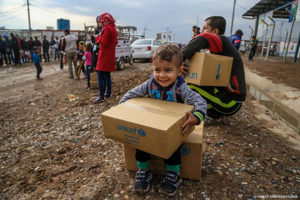You have no items in your cart. Want to get some nice things?
Go shopping With roughly a quarter of all the world’s children now living in war or disaster zones, and refugees and displaced people making up one in every 122 human beings on the planet, it is perhaps little wonder that the public are suffering a form of crisis fatigue when responding to even the most harrowing of news stories. Call it empathy deficit or whatever you like, but the fact is that as humanitarian crises happen more frequently – and perhaps worse, often seem to be ongoing with no sign of clear resolution – then getting the public to respond appropriately becomes increasingly difficult for journalists and writers.
With roughly a quarter of all the world’s children now living in war or disaster zones, and refugees and displaced people making up one in every 122 human beings on the planet, it is perhaps little wonder that the public are suffering a form of crisis fatigue when responding to even the most harrowing of news stories. Call it empathy deficit or whatever you like, but the fact is that as humanitarian crises happen more frequently – and perhaps worse, often seem to be ongoing with no sign of clear resolution – then getting the public to respond appropriately becomes increasingly difficult for journalists and writers.
The CNN effect
Adding to the problem is the fact that many disasters around the world just don’t make the international news, or at least not on a scale that commands worthwhile attention. This hampers relief efforts, as the public will always give more to the causes that are most heavily reported on. Politicians also respond to this “CNN effect.” A cynical interpretation would be that they respond more readily to the most visible crises because they want to be seen to be doing something. Meanwhile, desperate situations in other parts of the world go largely uncovered and as a result unaided.
Human suffering
In the case of reporting on these crises, the old adage that a picture is worth a thousand words still rings true. A single strong image that captures the suffering on a human level will attract an emotional response that bypasses the defences put in place by the rational mind. Where information can be processed as just that – information – pictures and video bring home the real tragedy in a way that can’t be rationalised away or easily forgotten.
The Penny Appeal charity works in over 30 crisis-hit countries, raising money to build wells and support schools, hospitals, orphanages and mosques. The charity encourages its supporters to give a small amount every day in a sponsorship scheme. Penny Appeal videos are a great aid in its fundraising drive, as when people see with their own eyes the situation in countries such as Syria or Somalia, they are far more likely to donate than if they just read the cold facts from a page.
Honest testimony
There are still ways to sway the public using words alone. Honest testimony by those affected, or eyewitness accounts, can do much to put the story on a personal level. When used alongside clear facts and a well-ordered narrative of how events occurred, using extensive quotes can help restore the reader’s empathy for the victims. This testimony should ideally be bolstered by a brief sketch of the person talking, allowing the reader to identify with them as a fellow human being and not just a statistic.
As disasters proliferate, honest reporting is needed more than ever, not just to support the essential work done by charities on the ground, but also to counter the rumour mill of social media and the propaganda masquerading as news that is easily put out by governments and organisations on all sides. Change is achieved by engaging the public, and a good writer should use unbiased but heartfelt reporting to make this happen.





